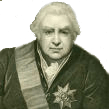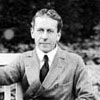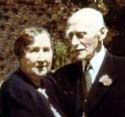Comments
from Mr. PGC: Throughout
history, many people have made lasting contributions to the
world of plants. In these pages, we hope to pay tribute to
some of them. Our concentration will be primarily on those
who have introduced plants to the gardening world, those who
have helped spread the word about gardening and those who
have made significant contributions to landscaping and
landscaping design around the world.
This list will be constantly growing as we add
new names. If you have someone who you think should be on
the list, please send us an
Email.
|
|
|
 |

|
-
Bacon, Sir Francis
-
Bailey, Liberty Hyde
-
Banks, Sir Joseph
-
Banyai, Pauline
-
Bartram, John
-
Beal, W.J.
-
Beauharnais, Josephine de
-
Beaumont, Guillaume
-
Bégon, Michel
-
Benedict, Ralph (Herb)
-
Bennerup, Pierre
-
Bergen,
Karl August von
-
Bigelow, Dr. Jacob
-
Blaikie, Thomas
-
Blomfield, Sir Reginald
-
Bloom, Adrian
|
-
Bloom, Alan
-
Bond, John
-
Bouganville, Louise Antoine de
-
Bowden, Roger & Ann
-
Bowles, E.A.
-
Bridgeman, Charles
-
Brown, Lancelot ('Capability')
-
Brunner, Samuel
-
Buchanan, John
-
Buddle, Rev. Adam
-
Budding, Edwin
-
Bulley, Arthur
-
Burbank, Luther
-
Burchell, William
-
Burkwood, Arthur
-
Burpee, W. Atlee
-
Butchart, Robert
|
 |
|
W.J. Beal |
|
|
 |
|
 |
 Although
known mainly as a philosopher, Bacon gardened extensively at his
estate at Gorhambury in Hertfordshire,
England. The notes he made
about the design and layout of the four-acre
water garden
may be found in the British Museum. Although
known mainly as a philosopher, Bacon gardened extensively at his
estate at Gorhambury in Hertfordshire,
England. The notes he made
about the design and layout of the four-acre
water garden
may be found in the British Museum.

|
|
 |
|
 |
 Born
in South Haven, Michigan, Bailey started his career at Michigan
Agriculture College (now
Michigan State
University) under the tutelage of W.J. Beal. In 1885, he established the
Department of
Horticulture and Landscape Gardening at Michigan State, the
first such department
in the U.S. In 1888, he became a
Professor of horticulture and botany at Cornell University and
became its Dean of the College of Agriculture. Born
in South Haven, Michigan, Bailey started his career at Michigan
Agriculture College (now
Michigan State
University) under the tutelage of W.J. Beal. In 1885, he established the
Department of
Horticulture and Landscape Gardening at Michigan State, the
first such department
in the U.S. In 1888, he became a
Professor of horticulture and botany at Cornell University and
became its Dean of the College of Agriculture.
Bailey was an
influential botanist and horticulturist who helped create the
modern study of cultivated plants. He and his daughter, Ethel
Zoe Bailey, compiled the massive work, Hortus: A Concise
Dictionary of Gardening, General Horticulture and Cultivated
Plants in
North America.

|
|
 |
|
 |
|
 Like
so many independently wealthy men of his era, Banks dabbled in
science as a hobby. He financed the botanical aspects of a world ocean expedition by Captain Cook and accompanied him on
the voyage to
search for new plants. In 1771, Banks returned from a trip to
Botany Bay in Australia with over 1,300 new plants. Like
so many independently wealthy men of his era, Banks dabbled in
science as a hobby. He financed the botanical aspects of a world ocean expedition by Captain Cook and accompanied him on
the voyage to
search for new plants. In 1771, Banks returned from a trip to
Botany Bay in Australia with over 1,300 new plants.
Later, Banks was appointed
horticultural and botanical advisor to the Royal
Botanic Gardens at Kew.
Sir Joseph served as President of the Royal Society for more than
40 years and funded plant collection expeditions by several
other well-known plant explorers. These adventurers were sent to
North America,
South America,
Africa,
Australia and South Seas where they were credited with
introducing over 7,000 exotic plants to Europe.
Included in the group sent out
by Banks were
Francis Masson (South Africa), Anthony Pantolean Hove
(India), David Nelson (Captain Cook's 3rd Voyage and with
Captain Bligh on HMS Bounty), Peter Good (Australia), George
Caley (New Holland) and William Baxter (Australia).
 Plant species associated with
Sir Joseph Banks often include the epithet
'banksii.' Some of them are
Grevillea banksii, Pterostylis banksii, Leptaspis
banksii, Onychoteuthis banksii, Hormosira banksii, Hibbertia
banksii, Heteronympha banksii, Astelia banksii,
Musa acuminata
subsp. banksii,
Cordyline banksii,
and Musa banksii. Plant species associated with
Sir Joseph Banks often include the epithet
'banksii.' Some of them are
Grevillea banksii, Pterostylis banksii, Leptaspis
banksii, Onychoteuthis banksii, Hormosira banksii, Hibbertia
banksii, Heteronympha banksii, Astelia banksii,
Musa acuminata
subsp. banksii,
Cordyline banksii,
and Musa banksii.

|

|
 |
|
 |
|
|
|
 |
|
 |
 John Bartram was
considered to be the first American born botanist who made a
significant impact on horticulture. He
was a farmer who lived near
Philadelphia where his home and gardens are being preserved
and are open to the public. John Bartram was
considered to be the first American born botanist who made a
significant impact on horticulture. He
was a farmer who lived near
Philadelphia where his home and gardens are being preserved
and are open to the public.
Throughout his life, Bartram travelled extensively in the
Eastern and
Southeastern U.S. in search of plants to send to
Sir Joseph
Banks and Peter
Collinson in
England. During
those years, he helped introduce
many American tree, shrub and herbaceous perennial species to
Europe. He also founded
the
Philadelphia Botanical Garden at Kingsessing,
Pennsylvania in 1728.
In 1777, he discovered an unusual flowering tree
on the banks of the Altamaha River in Georgia. He brought
seedlings back to his farm and named it
Franklinia in honor of his friend, one of the American
founding fathers, Benjamin Franklin.
Among his introductions to
England were
Mondarda didyma (beebalm,
Oswego tea, horsemint or
bergamot),
Phlox divaricata (woodland phlox),
Lilium superbum
(Turk's Cap Lily),
Actaea simplex (formerly
known as
Cimicifuga simplex),
and
Matteuccia struthiopteris (Ostrich fern).

|
|
 |
|
 |
 William
James Beal studied under
famed botanists,
Louis Agassiz
and
Asa Gray, at Harvard
University in the 1850s. He lectured in botany at the University of Chicago
before serving as Professor of Botany at Michigan Agricultural
College (now
Michigan State University) from 1870-1910 where one of his
students was
Liberty Hyde Bailey. William
James Beal studied under
famed botanists,
Louis Agassiz
and
Asa Gray, at Harvard
University in the 1850s. He lectured in botany at the University of Chicago
before serving as Professor of Botany at Michigan Agricultural
College (now
Michigan State University) from 1870-1910 where one of his
students was
Liberty Hyde Bailey.
In 1879,
Beal
designed what is now the oldest continuously operated botanical garden in
the U.S. on the M.S.U. campus in East Lansing, Michigan. Dr.
Beal began his famed plant vitality experiment with 1,000
seeds from twenty different plant species. The seeds were carefully
placed in glass containers, hermetically sealed and buried in a "secret" location at the
gardens. Periodically, staff of the gardens exhume a container of
seeds to check their viability. It has been found that certain seeds
will germinate even after being stored this way for 125 years.
Beal
wrote, The New Botany, in which he emphasized
naturalistic design with both native and exotic plants. His
outdoor laboratory (W.J.
Beal Botanical Garden) has expanded to 6 acres and over
5,000 species. The plants are divided into categories based on plant
families or economic uses.

|
|
 |
|
 |
 Josephine married the Vicomte de Beauharnais,
then Napoleon I, from whom she was divorced in 1809. Empress
Josephine gathered a famous nineteenth century collection of roses
at the Château de Malmaison. The roses she collected may still be
seen at l'Haÿ-les-Roses in
Paris. Josephine married the Vicomte de Beauharnais,
then Napoleon I, from whom she was divorced in 1809. Empress
Josephine gathered a famous nineteenth century collection of roses
at the Château de Malmaison. The roses she collected may still be
seen at l'Haÿ-les-Roses in
Paris.

|
|
 |
|
 |
|
Designer of the late 17th century exotic topiary garden at
Levens
Hall, Cumbria,
England between 1690 and 1720.

|
|
 |
|
 |
|
 French Canadian governor and
plant collector. The genus,
Begonia, is named for him. French Canadian governor and
plant collector. The genus,
Begonia, is named for him.

|
|
 |
|
 |
|
|
|
 |
|
 |
 Pierre
Bennerup is co-owner of Sunny Border Nurseries in Connecticut.
He has been a leader in the nursery industry and is credited
with originating the practice of shipping perennials in
containers rather than bare-root. Pierre was also instrumental
in the creation of the Perennial Plant Association in the 1980s. Pierre
Bennerup is co-owner of Sunny Border Nurseries in Connecticut.
He has been a leader in the nursery industry and is credited
with originating the practice of shipping perennials in
containers rather than bare-root. Pierre was also instrumental
in the creation of the Perennial Plant Association in the 1980s.
|
|
 |
|
 |
German professor for whom
the genus,
Bergenia, was named.
He is most noted for being the author of the book, Flora
Francofurtana, which was published in 1750.

|
|
 |
|
 |
|
 Nineteenth-century medical doctor and botanical designer of Mt.
Auburn Cemetery near Cambridge, Massachusetts. He was among the first in
the
United States to propose multiple uses for cemeteries such
as picnicking, civic ceremonies and general open space purposes. Nineteenth-century medical doctor and botanical designer of Mt.
Auburn Cemetery near Cambridge, Massachusetts. He was among the first in
the
United States to propose multiple uses for cemeteries such
as picnicking, civic ceremonies and general open space purposes.

|
|
 |
|
 |
A Scotsman who spent most of his time in
France, Blaikie laid out the gardens of Château de Malmaison for the
Empress Josephine. He also made the original plan
for the remarkable garden at
Bagatelle
in
Paris.

|
|
 |
|
 |

He was a proponent of a return to simpler and
less formal garden designs. Blomfield also designed the terrace garden at
Mellerstain in the
Scottish Borders and the Sulgrave Manor garden.

|
|
 |
|
 |
|
 Speaker, lecturer, author, plantsman and president of
Blooms of Bressingham Nursery in Norfolk,
England. He is the son of
famed plantsman, Alan Bloom
(see below). His gardens at
Foggy Bottom are noted
for their collections of conifers and heathers and are located
immediately adjacent to his father's famous,
Dell
Garden. Speaker, lecturer, author, plantsman and president of
Blooms of Bressingham Nursery in Norfolk,
England. He is the son of
famed plantsman, Alan Bloom
(see below). His gardens at
Foggy Bottom are noted
for their collections of conifers and heathers and are located
immediately adjacent to his father's famous,
Dell
Garden.

|
|
 |
|
 |
|

Alan Bloom was one of the great British
plantsman of the twentieth century. A gardener from the age of 16,
he bought Bressingham Hall, in Norfolk,
England in 1946 and founded a
world-renowned gardening dynasty that today spans three generations.
He was the creator of the six acre
Dell
Garden at Bressingham
where he pioneered the use of hardy perennials in "Island Beds"
which was a new concept
in the mid-1950's. As a plant breeder, he was also responsible
for breeding and introducing nearly 200
cultivars of herbaceous perennials. He was a founding member of the Hardy
Plant Society in 1958.
Among his most famous introductions are
Crocosmia masonorum 'Lucifer', Astilbe
x arendsii 'Sprite',
Achillea filipendulina
'Moonshine',
Geranium cinereum 'Ballerina',
Phlox 'Franz
Schubert', Trollius x cultorum 'Bressingham
Sunshine' and Veronica spicata 'Barcarolle'
Plants associated with the
Bressingham name include
Aconitum 'Bressingham Spire',
Bergenia 'Bressingham White',
Dicentra 'Alan Bloom',
Geranium psilostemon 'Bressingham Flair',
Hosta 'Bressingham
Blue' and
Thymus 'Alan Bloom'.


|
 |
 |
 John
Bond was described by at least one source as "...one of the
greatest plantsmen of the second half of the twentieth
century...". He was the Head Gardener at
Savill Gardens near
London, England. Earlier he worked at
Sir Harold Hillier's
nursery and at Bodnant Gardens in Wales. John Bond was heavily
involved with magnolias, rhododendrons and other woodland
plants. For the hosta world, he is best known for his
introduction of the classic cultivar H. 'Great Expectations'. John
Bond was described by at least one source as "...one of the
greatest plantsmen of the second half of the twentieth
century...". He was the Head Gardener at
Savill Gardens near
London, England. Earlier he worked at
Sir Harold Hillier's
nursery and at Bodnant Gardens in Wales. John Bond was heavily
involved with magnolias, rhododendrons and other woodland
plants. For the hosta world, he is best known for his
introduction of the classic cultivar H. 'Great Expectations'.
|
|
 |
|
 |
|
 The genus,
Bougainvillea,
was named for this French explorer who was the first Frenchman
to circumnavigate the world. The genus,
Bougainvillea,
was named for this French explorer who was the first Frenchman
to circumnavigate the world.

|
 |
 |


|
|
 |
|
 |
 English
amateur gardener and author of three classic books, My Garden
in Spring, My Garden in Summer and My Garden in
Autumn and Winter. English
amateur gardener and author of three classic books, My Garden
in Spring, My Garden in Summer and My Garden in
Autumn and Winter.
Among the plants named in his honor include
Erysimum 'Bowles' Mauve',
Crocus chrysanthus 'E.A.Bowles',
and
Viola 'Bowles' Black'.

|
|
 |
|
 |
|
 Bridgeman worked on
landscapes of a massive scale, creating gardens that used the
grass-clad shape of the land itself. His designs were used at
Claremont, Rousham Hall,
Blenheim Palace
in Oxfordshire, Stowe, Wimpole Hall, Wolterton Park and in
Kensington Gardens
in London. Bridgeman worked on
landscapes of a massive scale, creating gardens that used the
grass-clad shape of the land itself. His designs were used at
Claremont, Rousham Hall,
Blenheim Palace
in Oxfordshire, Stowe, Wimpole Hall, Wolterton Park and in
Kensington Gardens
in London.

|
|
 |
|
 |
Capability
Brown (His nickname came from his habit of saying that a place had
great "capabilities".) started as an under-gardener and finally the
head gardener to the Duke of Grafton. In 1764 he became the Royal
Gardener at Hampton Court Palace
where he continued to work until his death in 1782. The famous grape
vine which still exists there today is said to have been planted by
Brown.
 Brown is largely responsible for changing the English landscape
from a formal design of knot gardens, parterres, and topiaries to
informal, meandering paths, streams, serpentine lakes, and rolling
hills with scattered groupings of trees. He tried to create a "natural," yet
man-made, look to the landscape. He viewed his designs as tasteful improvements
on nature, yet also having some function and utility to man. Applauded by
many for his new style, he was criticized by others for destroying
so many of the prized formal landscapes and plantings of his time. Brown is largely responsible for changing the English landscape
from a formal design of knot gardens, parterres, and topiaries to
informal, meandering paths, streams, serpentine lakes, and rolling
hills with scattered groupings of trees. He tried to create a "natural," yet
man-made, look to the landscape. He viewed his designs as tasteful improvements
on nature, yet also having some function and utility to man. Applauded by
many for his new style, he was criticized by others for destroying
so many of the prized formal landscapes and plantings of his time.
His designs were used at
Blenheim Palace
(Oxfordshire), Bowood, Chatsworth (Derbyshire), Chilham Castle,
Claremont, Clumber Park, Croome (Worcestershire), Euston Hall,
Harewood House (Yorkshire),
Petworth House,
Luton Hoo, Sheffield Park, Stowe (Buckinghamshire), Syon Park
(Middlesex), Warwick Castle, Wimpole Hall and Wrest Park.

|
|
 |
|
 |
|
The genus,
Brunnera,
was named for this Swiss botanist.

|
|
 |
|
 |
|
 Born
in Scotland, Buchanan emigrated to
New Zealand in 1851 where he
was a gold prospector and surveyor. During his expeditions
throughout the country, he identified and made drawings of many new plant
species. Born
in Scotland, Buchanan emigrated to
New Zealand in 1851 where he
was a gold prospector and surveyor. During his expeditions
throughout the country, he identified and made drawings of many new plant
species.
Plants associated with him bear the name
buchananii including
Carex buchananii,
Clerodendrum buchananii,
Acaena
buchananii,
Aloe buchananii,
Hebe buchananii,
Pittosporum
buchananii,
Salvia buchananii,
and Newtonia
buchananii.

|
|
 |
|
 |
 Budding is the
Englishman credited with inventing the lawn mower in the 1830s. Before
then, sheep and other livestock or gardeners with scythes
trimmed lawns. His invention made expansive lawns possible and
popular, much as we see them today. Budding is the
Englishman credited with inventing the lawn mower in the 1830s. Before
then, sheep and other livestock or gardeners with scythes
trimmed lawns. His invention made expansive lawns possible and
popular, much as we see them today.
 Note:
It is up to you to consider the pros and cons of the impact of
this invention. Note:
It is up to you to consider the pros and cons of the impact of
this invention.

|
|
 |
|
 |
|
British botanist and
clergyman who published an English flora book in 1708. The genus,
Buddleia, (butterfly bush) was
named for him by
Linnaeus.

|
|
 |
|
 |
 A
wealthy cotton trader, his private garden in Cheshire,
England
later
became the Ness Botanic Gardens. He was especially interested in
primroses and the species,
Primula bulleyana is named for
him. Other plants bearing his name include
Adenophora
bulleyana,
Iris bulleyana and
Salvia bulleyana. A
wealthy cotton trader, his private garden in Cheshire,
England
later
became the Ness Botanic Gardens. He was especially interested in
primroses and the species,
Primula bulleyana is named for
him. Other plants bearing his name include
Adenophora
bulleyana,
Iris bulleyana and
Salvia bulleyana.

|
|
 |
|
 |
|

From his
home in Santa Rosa,
California and nearby Sebastopol,
Burbank conducted his experiments in plant breeding. During his
50 year career, he introduced more than 800 new varieties of
plants including over 200 varieties of fruits, many vegetables,
nuts and grains, and hundreds of ornamental flowers.

|
|
 |
|
 |
 Burchell
began his career working at the
Royal
Botanic Gardens at Kew
and later became Superintendent of the Botanic Gardens on
the Island of St Helena of 1805. Around 1815, he moved to
South Africa where he did an extensive amount of scientific
travel. During his years there, he collected over 63,000
specimens of plants and animals to document the species
found in the region. In 1825, he went to Brazil and spend 5
years collecting plants from remote regions of the country. Burchell
began his career working at the
Royal
Botanic Gardens at Kew
and later became Superintendent of the Botanic Gardens on
the Island of St Helena of 1805. Around 1815, he moved to
South Africa where he did an extensive amount of scientific
travel. During his years there, he collected over 63,000
specimens of plants and animals to document the species
found in the region. In 1825, he went to Brazil and spend 5
years collecting plants from remote regions of the country.
|
|
 |
|
 |
|
With his brother, Albert, he
started the Parkwood Nursery in Kingston Upon Thames, Surrey,
England. The specific epithet, burkwoodii, was
created in their honor. Plants containing this name include:
Cytisus scoparius
'Burkwoodii',
Viburnum
x burkwoodii,
Daphne x burkwoodii 'Carol Mackie',
Osmanthus x burkwoodii,
and Osmarea
burkwoodii.

|
|
 |
|
 |
 An
American seedsman and cousin of Luther Burbank, he was known as
a hybridizer of flowers and vegetables. By the late 1800's, his
seed company was the largest seed supplier in the world. An
American seedsman and cousin of Luther Burbank, he was known as
a hybridizer of flowers and vegetables. By the late 1800's, his
seed company was the largest seed supplier in the world.

|
|
 |
|
 |
|

In 1902, Robert Butchart established a
limestone quarry about 12 miles north of the City of Victoria on
Vancouver Island, British Columbia,
Canada. After the quarry was played
out by 1908, his wife, Jennie, began to beautify the area with
plants. She had thousands of cubic yards of soil brought in and
the beautiful gardens were soon attracting large numbers of
visitors. It is estimated that thousands of
 people toured
Butchart Gardens
each year during the 1930's. people toured
Butchart Gardens
each year during the 1930's.
World War II caused a shortage of labor and
the gardens went into decline. After the death of the Butcharts,
their grandson, Robert Ian Ross returned the gardens to their
former glory. The Ross family continues to own and operate the
gardens.

|
|
 |
|

